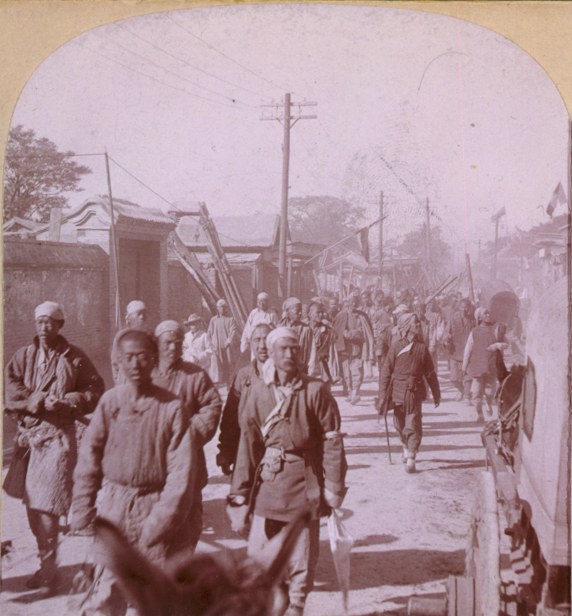Facts for Kids
The Boxer Rebellion was a violent anti-foreign and anti-Christian uprising in China, driven by nationalist sentiment and suppressed by an international coalition of foreign powers between 1899 and 1901.
Overview
International Response
Consequences And Impact
Cultural Representation
Key Players And Factions
Major Events And Timeline
Historical Interpretations
Causes Of The Boxer Rebellion
Legacy Of The Boxer Rebellion

Inside this Article
Empress Dowager Cixi
Chinese People
United States
Qing Dynasty
Chinese
Beijing
Culture
China
Boxer
Did you know?
🇨🇳 The Boxer Rebellion occurred in China from 1899 to 1901.
⚔️ It was an anti-imperialist uprising led by the 'Boxers,' a secret society.
🌍 The rebellion aimed to eliminate foreign influence and promote Chinese nationalism.
💥 The Boxers targeted foreign nationals, Chinese Christians, and anyone associated with foreign powers.
🏛️ Eight nations eventually intervened militarily to suppress the Boxer Rebellion.
📜 The uprising was partly fueled by anti-foreign and anti-Christian sentiments.
⚖️ The Boxer Protocol was signed in September 1901, officially ending the rebellion.
🔫 The conflict resulted in significant casualties, with estimates ranging from 100,000 to 200,000 deaths.
💰 Following the rebellion, China was forced to pay large indemnities to the foreign powers involved.
🛡️ The Boxer Rebellion highlighted the growing resentment against Qing Dynasty rule and foreign domination.
Introduction
Many people were unhappy with foreign countries telling China what to do! The "Boxers," a group of Chinese people, wanted to push out the foreigners and stop missionaries from spreading Christianity. They believed they could become strong by practicing martial arts and even thought they could be bulletproof! 🥋
The rebellion made big changes in China and affected many countries around the world.
International Response
Countries around the globe, including the United States, Russia, and Germany, sent troops to stop the Boxers. This international force included about 8,000 soldiers! 🤝
They wanted to protect their people living in China and keep trading routes safe. In response, China had to sign treaties which limited their power and let foreign countries gain more influence.
Consequences And Impact
After the rebellion, China had to pay a lot of money as punishment, around $333 million! This led to increased foreign influence in China and weakened the Qing Dynasty. Additionally, the event made people want to reform China and bring changes in government! 🏰
The rebellion showed the world that China wanted to stand up for itself, leading to more voices for change in the years to come.
Cultural Representation
Some stories tell about the brave Boxers fighting for their beliefs and culture. One famous movie is "The Boxer Rebellion" which shows this historic event. 🎬
Children's books also share tales of the Boxers, teaching kids about China's history through fun illustrations. Many in China still remember this time as a part of their rich culture and heritage!
Key Players And Factions
They all had different interests in China, which made the conflict even more complicated!
Major Events And Timeline
In 1899, the Boxers began organizing and attacking foreigners. By June 1900, they surrounded Beijing and attacked the Legation Quarter, where foreigners lived! 🏙
️ On August 14, 1900, an international relief force, including soldiers from different countries, entered Beijing to save the foreigners. Finally, the Boxer Protocol was signed in September 1901, which ended the rebellion and imposed rules on China.
Historical Interpretations
Some believe the Boxers were heroes fighting for Chinese culture, while others see them as violent and misguided. Different interpretations help us learn about the complexities of history! 🤔
Many agree that the rebellion was a key moment in China’s fight for identity and independence. So, understanding different perspectives can aid in understanding the past!
Causes Of The Boxer Rebellion
Foreign nations wanted to trade with China, and they built railroads and factories. This made some Chinese farmers lose their land. 🌾
Another reason was the spread of Christianity by missionaries. Many locals felt that their traditional beliefs were being ignored. The Boxers wanted to fight back against what they saw as unfair treatment and protect their culture!
Legacy Of The Boxer Rebellion
It helped encourage movements in China to fight for independence and reform. Organizations began to form, leading to the end of the Qing Dynasty in 1911! The rebellion also impacted how foreign countries viewed China, and many began to realize the importance of cooperation and respect. Understanding the Boxer Rebellion helps us learn about standing up for our beliefs and the culture we cherish! 🌏

